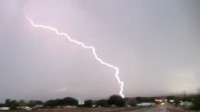I heard this on ABC news. Since it involves plumbing (sort of,) I thought I’d pass it along:
As the summer’s crazy weather brought another weekend of deadly lightning strikes, this time at a Pennsylvania auto racing event, Americans are reminded of the myths surrounding the dramatic and dangerous spectacle of Mother Nature as well as tips to keep safe.
Severe weather left one NASCAR fan dead and nine injured this weekend after lightning struck behind the stands at Pennsylvania’s 400 Sprint Cup Race at the Pocono Raceway near Scranton.
“When things started to clear up all we saw was a camping tent destroyed and two bodies on the ground,” racing fan Kyle Manger told ABC News.
A severe storm warning had been issued about 45 minutes before the strike, and fans had been advised over the public address system and through social media to take cover.
Here are three tips — and three myths — about lightning, should you encounter a severe weather situation, with or without similar warnings.
“Half the people that die from lightning strikes in the U.S. this year were standing under trees and the other half were out in open fields,” chief meteorologist for KTRK, Tim Heller, told ABC News.
2. Do not use a corded telephone or anything plugged into the wall
Lightning can travel through wiring and plumbing — so even if you’re indoors, you must still be cautious.
3. Stay away from sinks, tubs and showers
And if going inside isn’t an option, seek shelter in a car with a hard top. That way, even if the car is struck by lightning, it will travel through the metal of the car and down into the ground, away from you.
Myths
1. Lightning never strikes the same place twice
False! Take the Empire State Building for example — it gets struck around 25 times each year.
2. If it isn’t raining, you don’t have to worry about lightning
That’s not true either. Lightning can travel up to 25 miles from a storm. So even if the storm seems far away, lightning may still be a threat.
3. You’re safer if you lay flat or get close to the ground
People used to think that getting low to the ground meant you were less likely to be struck by lightning. But that’s not true either. It doesn’t matter how tall you are, if you’re not indoors, you’re at risk.
So bottom line, go inside if you see lightning — no matter how close you may think it is.
